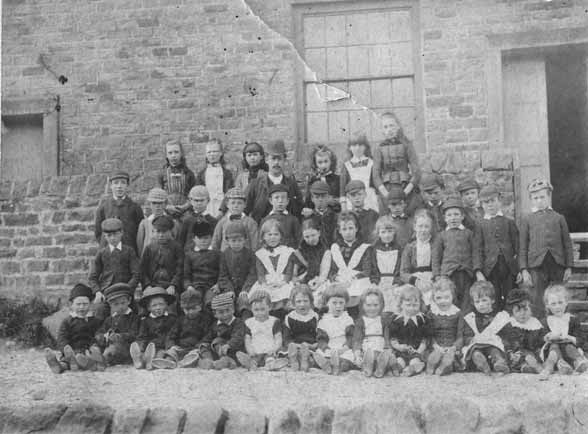
A Little "Clogs" History
Lori posted an e-mail to WEST-RIDING-L@rootsweb.com in regards to "Clogs".
The e-mail read as follows:
"Hi Listers,
Clog makers in the 1891 census... Did Yorkshire people wear them..?
Sorry for my ignorance but I thought only the Dutch wore them.
The origins of why they wore them...? And what is the meaning of these few words...
"Clogs to clogs in three generations"..
Does it mean only workers wore them...?
Kind regards
Lori Mitchell - Oz"
Thanks to everybody who sent
us information.
And the Web Site on what they look
like
They look very comfortable!
Following are some of the MANY responses we received from the good people of Yorkshire/Lancashire:

School Children of Low
Row (Swaledale, North Riding), taken in 1888.
(With thanks to Colin Hinson of West Riding,
Yorkshire, England.)
Yes - they were very commonly worn in the mills in both Yorkshire and
Lancashire. We had a family friend who was a shoemaker and he made me a pair
in about 1946. He lived in Bowling just opposite St John's Church round the
corner from Bolling Hall!
All the best
Anne
Certainly in Bradford clogs were the usual wear in the mills well into the 20th. century,
especially in wool combing where the concrete floors were thick with wool grease. It was either
clogs or bare feet (not uncommon) to keep yourself standing upright-all for one pound, four
shillings for a six day week. Even in the 1930s we had one or two lads in class regularly
wearing clogs with iron 'shoes' on the soles.
Glyn Lonsdale
Dear Lori, Clogs. They certainly wore them in Lancashire especially the
mill people. There was a clogger in Burnley long after I came here in 1952.
My mother would never allow me to wear them where we lived in Kirkham Nr
Preston. I would have loved to make sparks as the other children did with
kicking the clog irons onto the road. I think mother thought that as the son
of the village policeman we were slightly up the social scale from the clog
wearing natives. Alan (Penrose) Binns. Perhaps they didnt wear clogs in
Cornwall.
Hello, Lori,
Yes, large numbers of mill workers wore clogs to work in the 1850 to 1950
period, one of the largest clog makers in Yorkshire, was WALKLEYS of Hebden
Bridge.
If you use the Google search engine and insert .... Walkleys+clogs+Hebden
Bridge ... you should find a list of web pages to interest you.
Walkleys factory still stands, but is now mainly a "Craft Centre" but the
last time I was there, a couple of years ago, they were still giving
demonstrations of the art of Clog Making, and selling just a few pairs.
Regards,
Gordon
You bet we wore clogs. Not quite the same style as the Dutch, ours were
like boots with wooden soles. Still made today over in Sowerby bridge.
Don
Hello Lori,
I have a lovely pair of size 11 made in Oswaldtwistle, Lancashire and I wear
them when I am in the garden.
Kind regards
Laurie
Hi Lori
I ued to wear them in the forties, but they weren't like dutch clogs
which are made out of a single piece of wood.
The clogs I wore, had a wooden sole with thick leather uppers,
fastened on with domed nails. To make them last longer the sole and
heel had shaped pieces of iron, similar to horseshoes nailed on.
We used to slide on the cobbles, to see who could make the best
sparks, but they were useless for climbing trees. You also learnt to
be quick on your feet, when playing football (no cissy shinpads).
Clogs were worn by adults in the woollen mills, into the late 1940's
and were worn because the floors were stone and very cold and the wood
was a good insulator, and the soles didn't slip on greasy floors. My
brother wore steel toe-capped ones in the 1950/60's when he worked as
a blacksmith, mainly because metal splinters didn't pierce the sole.
Regards John
Hello Lori
Did and still do, quite fashionable a few years back. Our clogs are not
solid wood, more like boots with wooden soles
Steve Gaunt
Hi Lori,
Clogs were worn by miners in Yorkshire. They weren't made completely from
wood as the Dutch ones were. The ones over here had soles made from wood and
leather uppers or tops.
Maureen
Interesting subject. My grandfather limped all his life because of a wound in his thigh
sustained from a clog iron which stuck there during a playground fight in his schooldays.
I remember wearing clogs well myself... those lovely sparks!
During the protests against the introduction of machinery in the 19th century,
workers would drop their clogs into the machinery in order to break or to stall it.
Thus "to clog up the works." The same happened in France, the French using
their "sabots," from which come "sabotage" and "saboteur."
Ken Sutcliffe